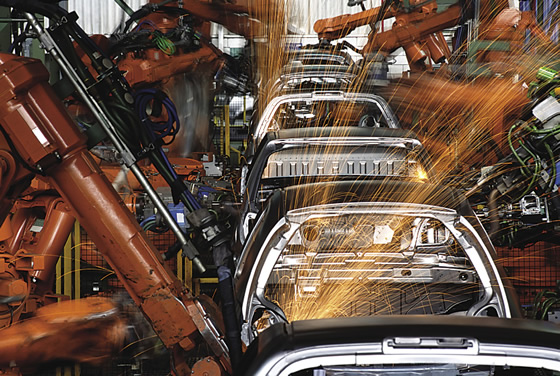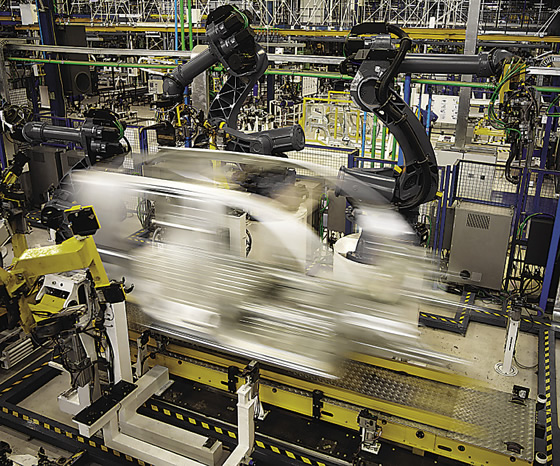Surging ahead
Surging ahead
Growing U.S. auto market needs supply flexibility and more lightweight parts.

Growing U.S. auto market needs supply flexibility and more lightweight parts.
The big comeback continues. After surviving a near-death experience in 2009, the U.S. auto industry has continued to grow, returning to pre-Great Recession annual production levels, and those levels should continue for the near future.
That's good news for auto manufacturers and their suppliers. Total new vehicle retail sales in the U.S. were expected to reach 6.5 million for the first half of 2014, a 6 percent increase over the first half of 2013, according to automobile market analyst J.D. Power and Associates, Westlake Village, Calif. The firm noted extreme weather conditions in early 2014 may have hampered some sales, but even so, sales increased on an annualized basis for each of the first 6 months of 2014. Total sales (including retail and fleet buyers) through the first half of 2014 were expected to reach 8.1 million vehicles, a 4 percent increase over the same period in 2013, based on a jointly developed forecast by J.D. Power and LMC Automotive US Inc., Troy, Mich.
Down the road, automotive consulting group IRN Inc., Grand Rapids, Mich., forecasts North American light vehicle production (cars and small trucks) increasing from 16.7 million units in 2014 to 17.8 million units in 2018, before dropping back to 17.6 million units in 2019. Compare that to 2009, when annual U.S. production was barely more than 10 million units.
Also, new-vehicle transaction prices for the first 6 months of 2014 are at record levels, averaging $29,630, an increase from $28,880 a year ago, according to J.D. Power. Consumer expenditures on new vehicles through the first half of the year also are at a record high of $194 billion, a $14 billion increase from the same period in 2013.
Auto information provider Kelley Blue Book Co., Irvine, Calif., reported an even higher average transaction price, with an estimated average of $32,556 in July for light vehicles (autos and small trucks) in the U.S. New car prices increased by $662, or 2.1 percent, from July 2013.
Hitting the Accelerator
There are several trends driving the growth in auto sales. One is the industry is making up for sales lost during the Great Recession. The average age of automobiles has been steadily increasing over the last 2 decades, and it increased sharply during the recession, as consumers put off purchasing new vehicles or purchased used ones. Even with the post-recession recovery in auto sales, the average age of U.S. vehicles continued to grow, reaching 11.4 years in 2013, compared to 8.4 years in 1995 and 10.1 years in 2008, according to the U.S. Department of Transportation's Bureau of Transportation Statistics.
"When you have a 12- to 13-year-old vehicle, you really can't repair it forever, so there is pent-up demand with the North America automotive vehicle population continuing to age," said Kim Korth, founder of IRN and president of Techniplas Group, Nashotah, Wis., a plastics manufacturer focused on automotive and industrial products.
Another factor propelling U.S. auto sales is that higher-income buyers are making the purchases. While average U.S. income growth is slower than it was prior to the Great Recession, which might tend to restrain auto purchases, 60 to 70 percent of new vehicles are being purchased by 25 percent of the population, and that group tends to have higher than average education and income, according to Korth.
For those with lesser financial resources, automakers and lenders are making very long-term loans available to buyers. For example, loans with terms of at least 72 months account for 31.8 percent of retail sales in the first half of 2014, up from 30.2 percent in 2013, according to J.D. Power.
Stable Industry
Oil and gasoline prices have stabilized in recent years, making the market for new vehicles more predictable for U.S. automakers. Since October 2010, the price of crude oil has remained in a range from $80 to $110 per barrel and was trading at $93 per barrel in July.
"If you look at oil prices, this has been an era of unprecedented stability, even considering the big spike in 2000, much of which was driven by speculation," Korth said. "The current generation of medium-size SUVs are getting miles per gallon in the upper 20s to low 30s and large sport utility vehicles are routinely getting mileage in the mid to upper 20s, so there's no substantial reason other than subsidies to move in the direction of electric vehicles. We're not replacing the combustion engine but enabling it to do more through hybridization and other technologies while producing less emissions."

Courtesy of IRN
One change that Korth sees, however, is that automakers will be increasing vehicle complexity, producing many different types of vehicles to appeal to different parts of the market. "We're going to see more vehicle complexity, not less," she said. "Automakers will use common manufacturing platforms, but it will not be unusual to see 20 to 25 vehicle nameplates produced off of one platform. You're going to see a lot of choice, a lot of diversity and a lot of different products."
Auto suppliers will need to keep up with that kind of complexity by investing in flexible manufacturing capabilities so they can retool and produce different parts quickly.
While managing this new, more complex environment will be challenging, the good news for part manufacturers is that the growth in auto sales means there are more viable auto manufacturers to sell parts to. Manufacturers should take this opportunity to diversify their customer base, according to Korth. "Four to 5 years ago, there were five or six truly viable OEMs, but today there are literally 13 to 14 viable customer camps in the North American market. If you're a supplier and you have more than 40 or 50 percent of your sales with one customer, shame on you because this is currently a target-rich environment."
Lightweight Future
One certainty is that auto suppliers will be making parts from lightweight materials as automakers race to meet demanding federal standards for increased fuel efficiency in part by reducing average vehicle weight. Demand for lightweight materials in the North American light-vehicle market is projected to rise 5.2 percent annually to 22.3 billion lbs. by 2018, according to "Lightweight Automotive Materials in North America," a report by The Freedonia Group Inc., a Cleveland-based market research firm. Freedonia analyst Bridget McMurtrie said, "Advances in lightweight materials will significantly outpace gains in automotive materials overall. Regulatory pressure will be the major force propelling growth."

The best growth prospects are forecast for exterior and structural components, driven by R&D in lightweight materials suitable for these components. "This segment will account for nearly 75 percent of total average vehicle weight reduction through 2023, with body and frame applications alone accounting for about half," McMurtrie said. "Interior applications are relatively mature and will see only limited growth going forward, as plastics have long been used in interior components, thus restricting opportunities for further weight reduction."
The Freedonia report stated aluminum and high-strength steel are the primary materials being used to make automobiles lighter. "Aluminum will enjoy rapid growth in exterior and structural applications, as automakers explore the adoption of this material in place of steel for body components, such as closures and panels," McMurtrie said. "Additionally, automakers will closely follow Ford's highly publicized switch to aluminum for the body of its 2015 Ford F-150 pickup to determine whether they too will make a similar move. High-strength steel is predicted to offer the best opportunities for growth based on its relatively low cost compared to other lightweight materials and the ongoing development of new grades that provide a combination of exceptional strength and formability, which will make it the material of choice for structure and frame applications."
The report also noted engineered plastics will remain the leading polymer type used in autos through the forecast period, having successfully supplanted metals in several applications. Also, the report predicted that demand for high-performance composites will rise sharply, albeit from a small base, due to the materials' substantial potential for weight savings. The high cost of composites, however, is a barrier to widespread adoption.
New Drive Trains
The drive toward more fuel-efficient cars is also being powered by redesigned drive trains (engine, transmission, drive shafts and differentials) that use new technology to get more power out of small, light engines and transmissions. These technologies include disconnect systems on all-wheel-drive systems, which allow an AWD vehicle to use only its primary drive system—the front wheels—when AWD is not needed; electronic limited-slip differential systems, which electronically monitor input from wheel sensors and, in the event of a skid, transfer extra torque to the wheel or wheels with the most traction; power transfer units, which vary the torque sent to the rear wheels; and true torque vectoring technology, which provides the differential with the ability to vary the power to each wheel.
Today's passenger cars, on average, generate more horsepower and consume less fuel than ever before. To make autos even more efficient, the U.S. government reached an agreement in 2011 with 13 automakers to begin delivery of 54.5-average-mpg vehicles by 2025, up from 27.8 mpg in 2011.
The pressure will be on automakers and their suppliers to achieve this goal. "The time to introduce changes is when an automaker is launching a brand-new program, and even more so when they are launching a brand-new car frame," IRN's Korth said. "There will be a maximum of three design cycles between now and 2025 to achieve significant reduction in fuel economy. That's not a lot of time.
"By 2018, 70 percent of global vehicles will be brand-new or completely refreshed compared to 2013, which means suppliers will have opportunities and risks," she continued. "If you're a supplier to an existing program, you have the potential to be displaced. If you're not in that program, you have a selling opportunity. But the biggest risk is that most suppliers and most OEMs are not geared to launch that many programs, and we're already beginning to see some huge stumbles. The only way you can keep up with that complexity is to do things faster and smarter—and do them right the first time." CTE
Lightweight automotive materials demand (millions of pounds) | |||||
| % Annual growth | |||||
|
| 2008 | 2013 | 2018 | 2008-2013 | 2013-2018 |
| Total lightweight auto materials demand | 11,395 | 17,300 | 22,280 | 8.7 | 5.2 |
| Metals | 6,160 | 10,165 | 14,260 | 10.5 | 7.0 |
| Polymers and composites | 5,235 | 7,135 | 8,020 | 6.4 | 2.4 |
Courtesy of The Freedonia Group
Editor's Note: "Lightweight Automotive Materials in North America," a 375-page report published in June by The Freedonia Group, is available for $5,100.
Contributors
The Freedonia Group
(440) 684-9600
www.freedoniagroup.com
IRN Inc.
(616) 871-1955
www.think-irn.com
J.D. Power and Associates
(800) 274-5372
www.jdpower.com
Kelley Blue Book Co.
(949) 770-7704
www.kbb.com





